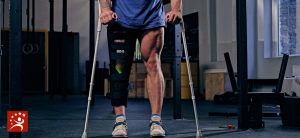Coloradans know that black ice not only is a winter phenomenon; it occurs in springtime, too, when temperatures soar during the day only to rapidly drop after sundown. No matter winter or spring, of the most common injuries associated with black ice is twisted or sprained ankles. Face it, black ice and the resulting hazards are simply a fact of life during Colorado spring. And the last thing you want to do is start your spring with a twisted ankle from wiping out on black ice. Here is what you need to know about the perils of Colorado’s black ice, twisted ankles and what you can do when gravity and the elements don’t work in your favor.
What is Black Ice?
Black ice derives its name from the nearly transparent ice that forms on roads and walkways, placing anyone who drives, runs, or walks on it in peril. Black ice occurs when temperatures drop below freezing, which rapidly cools whatever precipitation is on the roadways into a transparent and very thin sheet of extremely slippery ice. Black ice can also develop if low-level fog is present and the temperatures drop rapidly, cooling the fog into condensation and forming that thin sheet of ice.
Twisting Ankles
A twisted or sprained ankle is caused when the foot or ankle rolls past the point the ligament’s normal capacity. The resulting damage causes swelling, pain and a bruising – a sprain. What a twisted ankle is not is a broken ankle. In fact, the bone is unaffected when the ankle is twisted or sprained. That doesn’t mean it isn’t painful. There are three degrees of sprains:
– A first degree sprain is mildest and accompanied by minimal swelling and tenderness. Despite the pain, the tear is small and usually will take a few days to heal when treated with RICE (Rest, Elevation, Ice & Compression).
– A second degree sprain is more pronounced and quite painful, but can still bear some weight. Expect to be out of commission for a week or two. Your orthopedist may brace your ankle and will advise you to use the RICE method. They may also prescribe anti-inflammatory medications and recommend you take it very easy for a while to encourage healing and keep swelling at bay.
– A third degree sprain is the most serious, as the ligament has suffered a complete tear. Walking and any weight-bearing is not possible. Third degree sprains are often marked by purple and blue discolorations under the skin and require weeks to heal. You will likely be needing crutches or a scooter and you may not be able to drive if your right ankle is affected (or if you drive stick). Your orthopedist may cast the injury or create a splint for you; in some cases surgery may be recommended to repair the tear.
No Sprain, No Pain
A light sprain may seem inconsequential, but that is no reason to avoid seeing your orthopedist. Only medical imaging can confirm if the bone has been injured or if there is a sleeper injury that can compound over time. Remember, any delays seeking attention could result in more permanent issues. The longer you wait the greater your chances of lasting damage.
Your Orthopedic Experts in Colorado Springs
With spring just around the corner, don’t assume you are immune from the dangers of black ice. If you should find yourself in a twisted ankle conundrum, call Colorado Center of Orthopedic Excellence. As Colorado Springs’ experts in orthopedic and musculoskeletal medicine, they are the trusted caregivers of Olympians and people who just love the outdoors. Call them at (719) 623-1050 or request an appointment through their online portal here.








